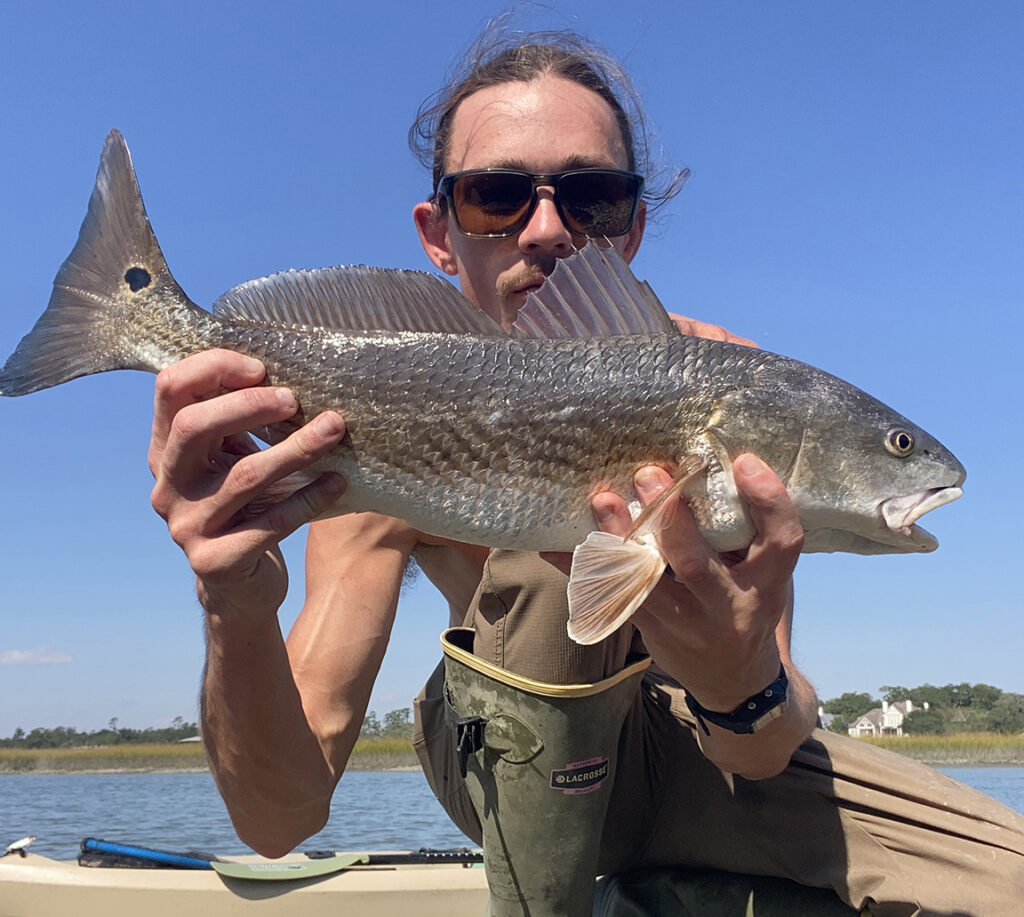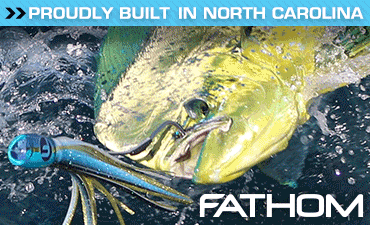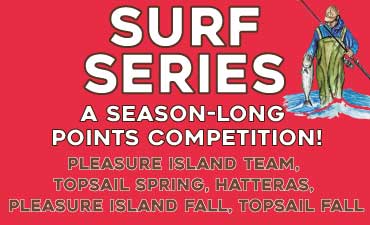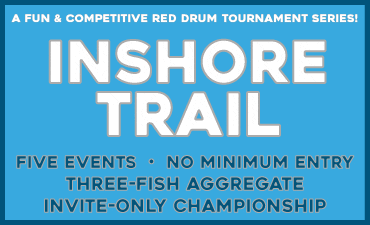Wrightsville Beach – March 2025
Tex, of Tex’s Tackle, reports that offshore anglers have enjoyed some solid wahoo and blackfin tuna action. Offshore boats have also found a bunch of amberjacks and barracuda.
With water temperatures so cold, it’s likely the king mackerel are still out in the 50-mile range.
Those looking to load up on some meat are finding keeper black sea bass in the 18-20 mile range.
Inshore anglers have done well on black drum.
Surf anglers are seeing sparse action at best, with the occasional sea mullet coming off the local piers, but there’s been nothing for surf or pier anglers to get excited about.
Looking into March, surf anglers could see some sea mullet showing, with bluefish arriving right behind the sea mullet.
Ben, of Intracoastal Angler, reports that the best bet for fishing action can be found in the Cape Fear River. Anglers are targeting striped bass around the downtown area. These schools of stripers are holding around structure and in some of the deeper water areas. They’re hitting weedless-rigged jerk shads or flukes and deep diver plugs.
Those fishing along the ICW have found a few red drum staged up around docks or in the backs of marshes. Most of the redfish are being enticed to bite with Carolina-rigged cut shrimp or lightly weighted, Ned-rigged soft plastics.
Some speckled trout are mixed about in the inshore waters, but they won’t be very active until temperatures warm up. The key for trout is to fish lighter fluorocarbon leaders and lightly weighted baits that “flutter” down through the water column.
Some black drum are staged up around the jetty and are also being caught from anglers fishing off local piers. Cut shrimp will work best for the black drum.
Those running out to bottom fish in the 20+ mile range are having a lot of success with large black sea bass. Cut squid on bottom rigs will do the trick.
Anglers making a Gulf Stream run are finding some wahoo.
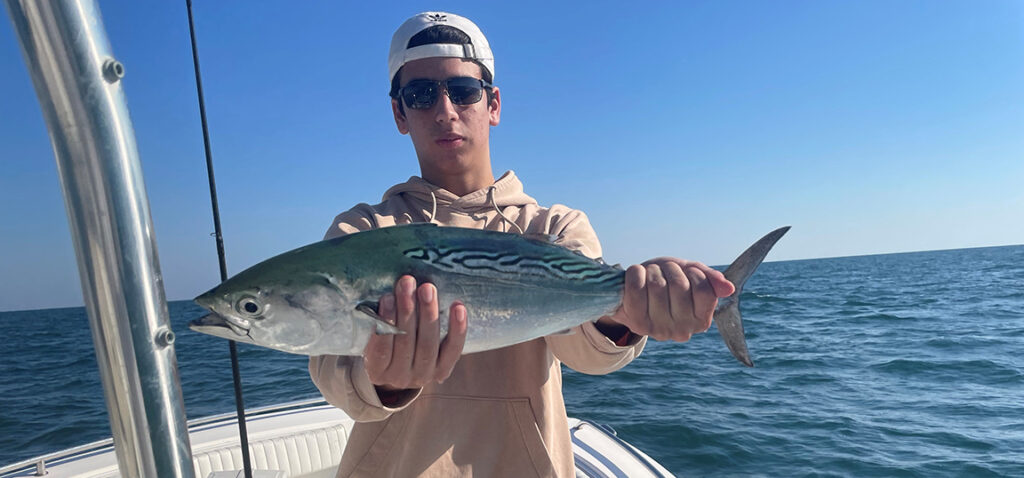
Ben Rodriguez, of Wilmington, caught this false albacore offshore of Wrightsville Beach on a Clarkspoon.
Luke, of Coastline Fishing Charters, reports that inshore anglers will do best by targeting schools of red drum in the backs of creeks or around docks in the creeks or along the ICW. Fresh shrimp or cut baits on Carolina-rigs have been the most reliable setup.
The black drum are feeding on the same offerings and are found more reliably around docks and near oyster beds.
Both species will become more active as the water temperatures warm. Once temperatures warm, the schools of fish break up. Anglers can still find them in the same areas, but just in smaller numbers.
The speckled trout bite has been decent, with most of the trout being found closer to the inlet or in deeper holes in the backs of the marsh. The trout are striking at a wide range of baits, but typically soft plastics seem to work best.
Off the beach, water temperatures warming should start to push in the first schools of Atlantic bonito in the 10-mile range, and they will continue to move in even closer. Anglers will initially have success trolling deep diver plugs closer to structure as it’s an easy way to find and locate fish before they show up in bigger numbers.
Pierre, of Rising Sun Fishing, reports that red drum continue to produce action for anglers targeting docks and flats in the backs of the mainland creeks. With water conditions so clear, a lot of the red drum fishing is very visual. The most effective tactic in early spring is for anglers to visually find fish, either by sight or electronics, before starting to work an area (versus blind casting).
Speckled trout are around, though anglers are not spending too much time targeting them. These fish are being caught with smaller baits, such as 3” soft plastics or MirrOlure MR-17s. With the cold-water temperatures, most of these fish have been in the lower parts of the water column.
Both black drum and sheepshead are feeding well for anglers bottom fishing cut shrimp or crab around docks and oyster bars in the backs of the creeks and along the ICW.
There isn’t much for fishing efforts going on at the jetties or nearshore wrecks, but anglers that have peeked out have caught smaller black sea bass, some sheepshead, and the occasional tautog.
Rick, of Living Waters Guide Service, reports that offshore trolling has been productive for wahoo and tuna on the shallow side of the break (150-225’). The best bets have been a mix of ballyhoo with Sea Witches and small Jags or pulling lures like the new Destroyer with the rubber tail. In that same zone, jigging (Roscoes and short Johnny rigs) and popping (Halco and Savage Gear) have been working for blackfins, amberjacks, and African pompano.
Look for yellowfin tuna to make a surprise showing anytime from mid-March to early-April.
Ben, of Southern Run Fishing Charters, reports that nearshore bottom fishing has been good for the bigger class of black sea bass. The best action comes with water temperatures in the high 50s to low 60s, which has mostly been in the 15-20 mile range. When out in this area, always be sure to be rigged with a casting jig on a spinning rod as it’s likely you’ll run across some false albacore on top.
The wahoo fishing has been hit or miss.
The one reliable offshore species has been blackfin tuna. Anglers getting out to areas around the Steeples have had good successes, as long as you can find that clean, warmer (70+ degree) water pushed in over some structure.
Chris, of Johnnie Mercers Pier, reports that with water temperatures still cool, not much is happening. Anglers who do catch a small window of weather and choose to come out are catching some whiting and a few black drum.


